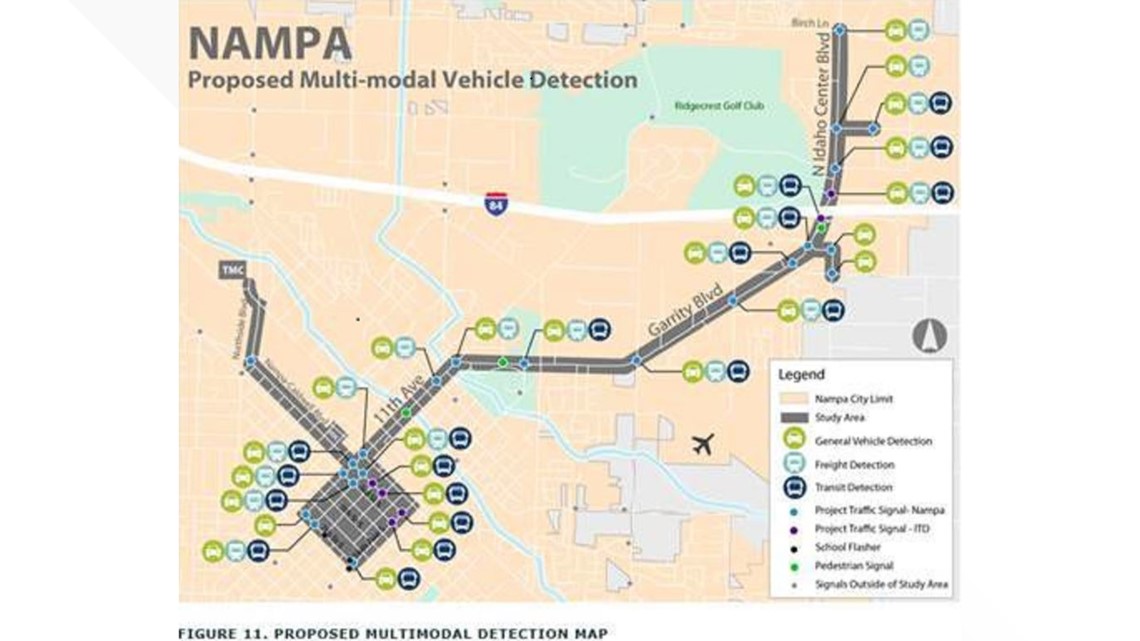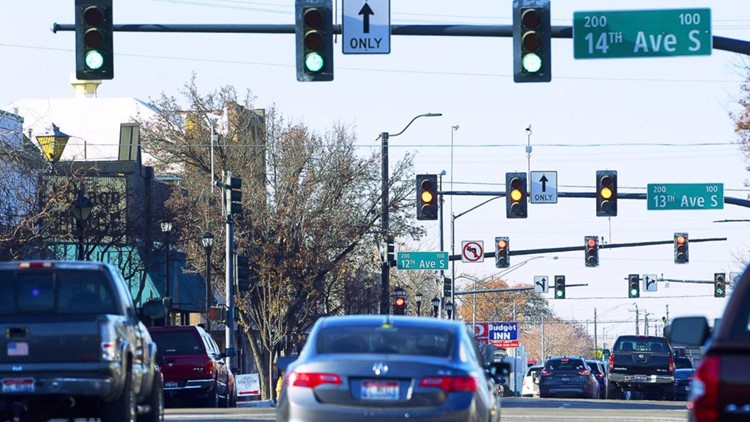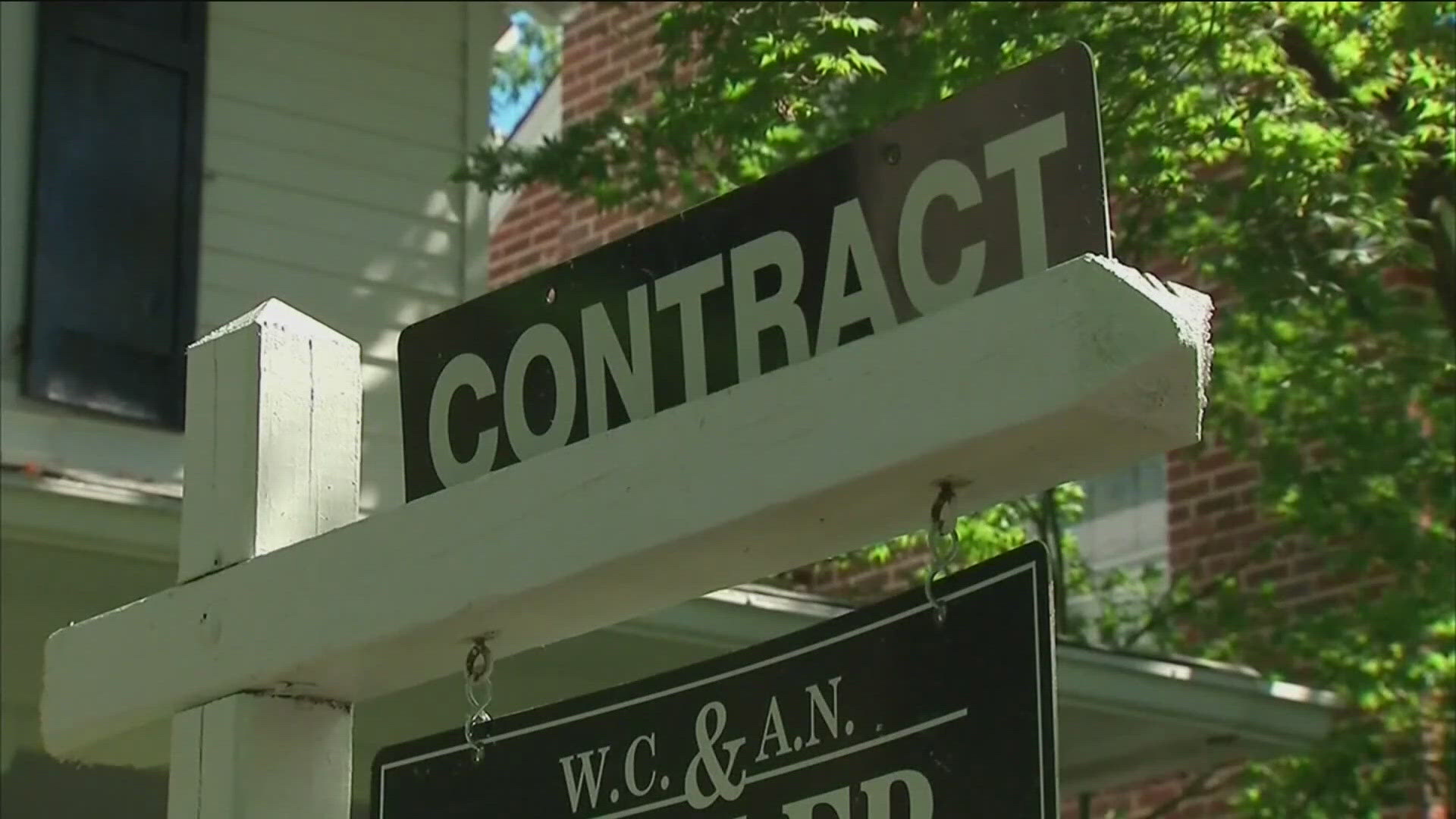NAMPA, Idaho — Long wait times at Nampa's stoplights are a source of frustration for local drivers.
Cars may hit multiple red lights in a row or get stuck at a long red light even when no other cars are around. Those situations can encourage drivers to run red lights, Nampa Police Capt. Brad Daniels said.
The Idaho Press reports the city is aiming to curb those frustrations and boost public safety with a new traffic signal network called an "Intelligent Transportation System." The system will bring the cameras at Nampa's traffic signals into one network that can be monitored and controlled from a remote location.
Installing the network citywide is expected to cost $5 million, so the city plans to phase in the system, according to Jeff Barnes, deputy public works director for transportation. One of the primary goals of the first phase is to improve the flow of freight traffic, he said.
Nampa has 60 traffic signals, along with 13 pedestrian signals. The first phase, expected to cost $2 million, would involve 27 signals mostly in downtown Nampa, north through Garrity Boulevard to the Idaho Center Boulevard.


Cameras will be installed at each of the 27 signals, which will be connected to a feed at a remote location. One or two city employees will monitor the feeds for traffic, and those employees will have the ability to change the timing of the signals to improve traffic flows and synchronize when lights turn green.
The project is a partnership between the city and the Nampa Police Department, which have had discussions dating back to last year, Daniels said.
"We started talking about how we can get the most juice for the squeeze," he said.
Nampa officials are applying for grants necessary to execute phase one. Nampa City Council approved up to $150,000 last week to match grant funding for the project, Barnes said.
TRAFFIC
Currently, Nampa's traffic signals are timed by a variety of systems, Barnes said.
Some signals, like the group of intersections around Library Square in downtown Nampa, are timed and coordinated with each other. Others use radar to detect when cars are waiting and influence the signal's timing. Barnes said a few signals have cameras installed, but they won't be in operation until they're connected to the larger network.
The Intelligent Transportation System, or ITS, will allow Nampa employees to change the timing of a traffic signal if they see a need. Barnes said the new system could help move heavy traffic when there is a big event at the Ford Idaho Center. An employee could also use ITS to aid a driver stuck at a long red light with no other cars moving through the intersection, he said.
The system will even have the ability to reset flashing traffic signals immediately. This process can normally take over an hour when city employees have to travel to the signal and reset it manually, Barnes said.
A major goal for the first phase of the system is to improve freight traffic, Barnes said. Nampa officials have historically valued industrial development within the city for its economic benefits.
"It's an economic engine for our city," Barnes said.
But the semi-trucks moving product have to go through the same downtown routes and main thoroughfares as passenger cars, which creates congestion.
Amazon is building a 650,000-square-foot fulfillment center in Nampa, slated to open in 2020. The delivery vehicles will rely heavily on the Garrity Interchange as a connection to Interstate 84, and Barnes said the facility is expected to increase traffic around the interchange by up to 10% at its peak hour.
Amazon officials agreed to contribute about $4.7 million — originally intended for a traffic improvement project at the interchange — to the city. The likelihood of that project happening is up in the air, as the Idaho Transportation Department, which owns the roads at the interchange, does not have the project on its priority list. The ITS, however, could manage the traffic signals at the interchange and relieve some of that congestion, Barnes said.
POLICE
The new system could also improve public safety. Daniels said the system can slow traffic in emergencies to help clear the path for emergency vehicles, and help police identify suspects during investigations.
While the remote location will show live feeds from the traffic signals' cameras, Daniels said the cameras will also record footage that officials can review later. If there is a crime or an accident near an intersection, police will have the ability to search for specific types of vehicles through the system, based on things like make and color, to identify a suspect's vehicle, he said.
The software will likely store the footage for one to four weeks, Daniels said. He said the police are aware of privacy concerns that this technology may create and will work to be sensitive to that.
Daniels gave the example of a homicide investigation the Nampa Police Department previously worked on. It took police about two months to apprehend a suspect in that case. With this system, he said it could have taken officers a matter of minutes to identify the suspect's vehicle and apprehend them.
WHAT'S NEXT
If everything goes well, Barnes said it could take two to three years to finish the first phase of the system. He said other cities across the U.S. are using this technology.
Corona, California, is one of those cities. With a population of more than 147,000 at the time, the city implemented its software, called an Advanced Traffic Management System, in 2005, according to the city's website. Since then, the city's population has grown to more than 167,000 and the system has expanded to cover more than 70 signals. Corona officials claim the system helped the city become a leader in California's traffic industry.
Nampa recently surpassed 100,000 people and is growing about 3.7% each year, according to the Community Planning Association of Southwest Idaho. Barnes said Nampa is a large enough city to warrant this level of technology.
"This is a higher level of timing," Barnes said.
More from our partner Idaho Press: Without reaching a compromise with county officials, Caldwell to reconsider urban renewal district proposal
Watch more 'Growing Idaho':
See them all in our YouTube playlist:




